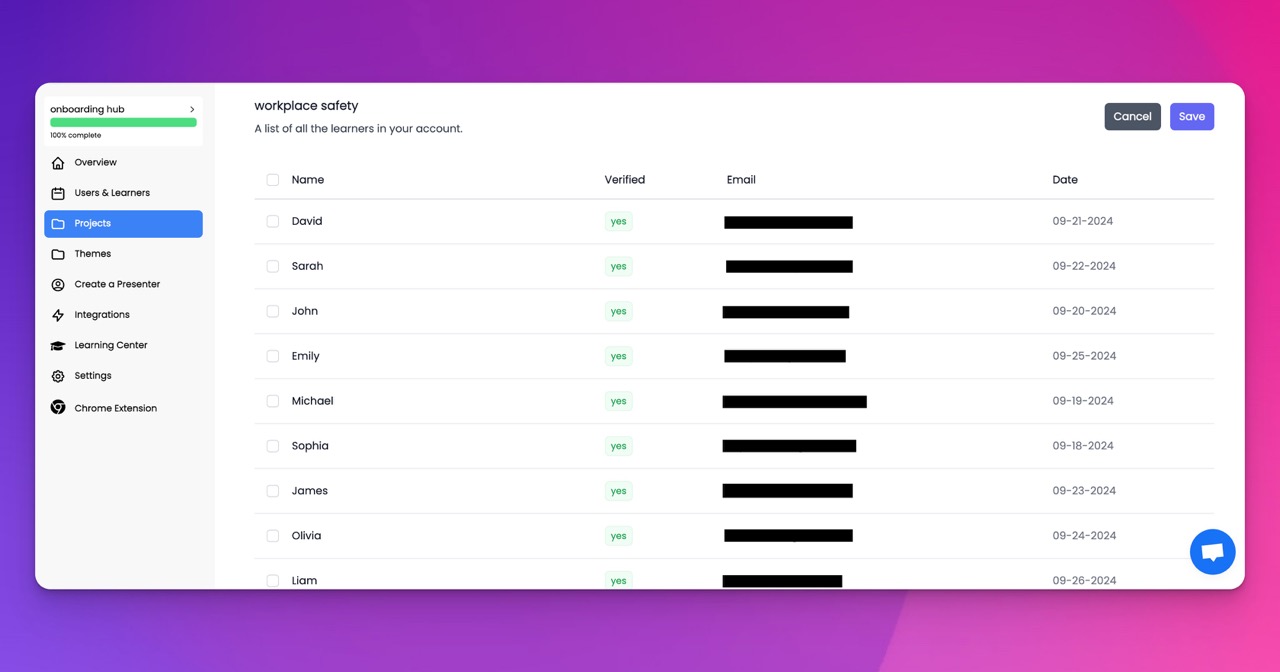🎉 Trainday now integrates with Zendesk and Hubspot 🎉 Trainday now integrates with Zendesk and Hubspot 🎉 Trainday now integrates with Zendesk and Hubspot
🎉 Trainday now integrates with Zendesk and Hubspot
🎉 Trainday now integrates with Zendesk and Hubspot
Contact
Onboarding Reimagined - How Technology Transforms New Hire Integration
The onboarding process is a critical phase in any organization, setting the tone for a new hire's experience and laying the foundation for their future success. Traditionally, onboarding has involved a series of manual processes, paperwork, and face-to-face training sessions. However, with the advent of advanced technology, onboarding is being reimagined in ways that enhance efficiency, engagement, and effectiveness. "Onboarding Reimagined: How Technology Transforms New Hire Integration" explores the transformative impact of modern technology on the onboarding process and how it helps companies integrate new employees more seamlessly.
The Traditional Onboarding Challenges
Traditional onboarding processes often face several challenges:
Time-Consuming Procedures: New hires typically go through lengthy processes involving paperwork, manual training sessions, and repetitive administrative tasks.
Inconsistent Experiences: Depending on the department or manager, the quality and thoroughness of the onboarding experience can vary, leading to inconsistencies in training and integration.
Information Overload: New employees are often overwhelmed with a barrage of information in a short period, making it difficult to retain and apply what they've learned.
Lack of Engagement: Traditional onboarding can sometimes feel like a checkbox exercise, leaving new hires disengaged and uninspired.
The Role of Technology in Modern Onboarding
Technology is transforming the onboarding experience by streamlining processes, personalizing training, and enhancing engagement. Here’s how:
Digital Onboarding Platforms
Digital onboarding platforms like Trainday offer a centralized hub where new hires can complete paperwork, access training materials, and track their progress. These platforms automate administrative tasks, freeing up time for more meaningful interactions and reducing the time-to-productivity for new employees.
Personalized Learning Paths
AI-powered platforms can create personalized learning paths tailored to the specific role and needs of each new hire. These paths ensure that new employees receive the right information at the right time, making the learning process more efficient and less overwhelming.
Interactive and Engaging Content
Modern onboarding leverages interactive content, such as quizzes, videos, and simulations, to make learning more engaging. This approach not only enhances retention but also allows new hires to apply what they've learned in a practical, hands-on way.
Real-Time Feedback and Support
Technology enables real-time feedback and support, allowing new hires to ask questions and receive answers instantly. This immediacy helps resolve doubts quickly and ensures that new employees feel supported throughout their onboarding journey.
Seamless Integration with Existing Systems
Today's onboarding platforms often integrate seamlessly with other HR and company systems, such as payroll, benefits administration, and project management tools. This integration ensures that new hires are fully equipped and ready to contribute from day one.
Benefits of Technology-Driven Onboarding
The integration of technology into the onboarding process offers several significant benefits:
Reduced Time to Productivity
By streamlining administrative tasks and providing structured, efficient training, technology reduces the time it takes for new hires to become productive members of the team.
Enhanced Employee Engagement
Interactive and personalized onboarding experiences keep new hires engaged and motivated, leading to higher levels of job satisfaction and retention.
Consistency Across the Organization
Digital onboarding platforms ensure that every new hire receives a consistent and high-quality onboarding experience, regardless of their department or location.
Data-Driven Insights
Technology provides data-driven insights into the onboarding process, allowing companies to track progress, identify areas for improvement, and continuously refine their approach.
Improved Compliance and Accuracy
Automating compliance-related tasks, such as completing forms and certifications, ensures accuracy and reduces the risk of errors, keeping the company compliant with regulations.
Real-World Applications
Imagine a company expanding rapidly across multiple locations. Ensuring a consistent onboarding experience for every new hire could be a logistical nightmare. However, by implementing a digital onboarding platform like Trainday, the company can create a standardized onboarding process that every new hire, regardless of location, can access. This approach ensures that all employees receive the same high-quality training and integration experience, fostering a unified company culture.
Another scenario could involve a company onboarding remote workers. Technology-driven onboarding allows remote employees to feel just as integrated and supported as their in-office counterparts. Through virtual training sessions, digital paperwork, and interactive content, remote employees can quickly get up to speed and feel connected to the organization.
The Future of Onboarding
As technology continues to evolve, the onboarding process will become even more streamlined, personalized, and engaging. AI and machine learning will play increasingly significant roles in predicting the needs of new hires, customizing their onboarding experiences, and providing ongoing support throughout their tenure.
Companies that embrace technology in their onboarding processes will be better positioned to attract, retain, and develop top talent. The result is a workforce that is not only well-prepared and productive but also deeply engaged and committed to the company’s success.
Conclusion
"Onboarding Reimagined: How Technology Transforms New Hire Integration" highlights the profound impact that modern technology has on the onboarding process. By leveraging digital platforms, AI-driven learning paths, and interactive content, companies can create a more efficient, consistent, and engaging onboarding experience. As the workplace continues to evolve, embracing these technological advancements will be key to ensuring that new hires are integrated smoothly and effectively, setting them up for long-term success.
Accelerate Compliance.
Deliver OSHA-Ready Courses Instantly.
Empower your team with data-driven training solutions tailored to your industry's safety standards. Stay compliant, reduce risks, and boost productivity with AI-powered course creation.
